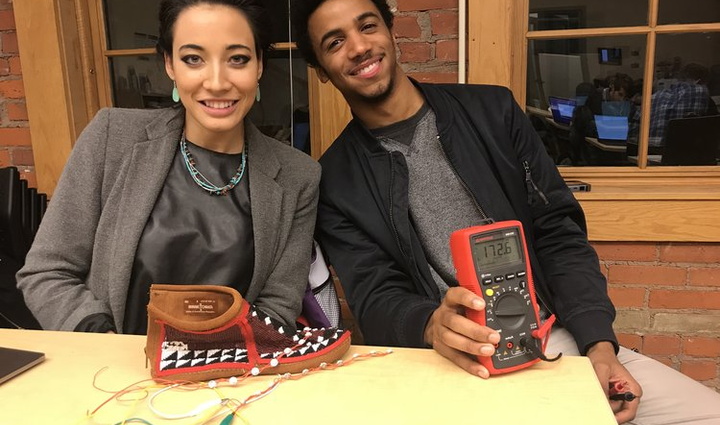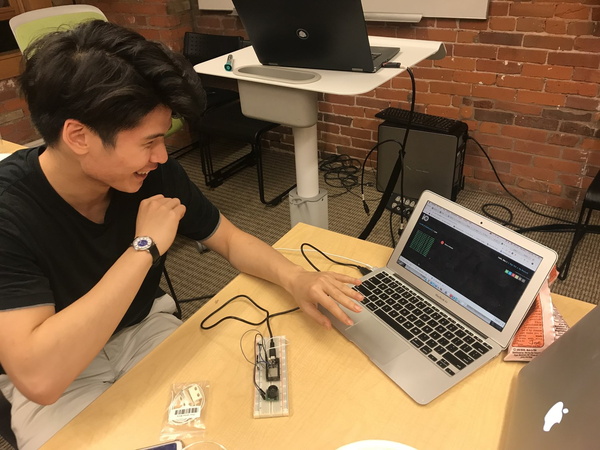Multi-Disciplinary Students Dive into the Internet of Things
“Smart” devices are everywhere, from the Amazon Echo to the Fitbit. This fall, students from all corners of campus had a chance to imagine and prototype their own smart devices and systems as part of a cohort-based Intensive held at Tsai CITY.

Over the course of five three-hour sessions, students learned the basics of the “Internet of Things” (IoT) — the term used to describe the rapidly growing network of internet-connected physical objects — and applied this technology in creative directions, from technology-enhanced attire to a system for tracking movements on stage.

Levi DeLuke (YC ’14), a mentor-in-residence at CITY who co-led the Intensive with Jonathan Simonds (YC ’18), was motivated to offer the Intensive in part because of the relative accessibility of IoT technology. In recent years, the availability of low-cost tools like basic sensors and microcontrollers (compact integrated circuits, like the popular Arduino line) have opened doors to prototyping smart devices quickly and without much budget. “IoT is a broad term, applicable to lots of different fields, like healthcare, sustainability, consumer devices, art,” says DeLuke. “It’s useful for a wide range of applications, and it’s incredibly easier to get into than people think — it doesn’t have many barriers for applications.”
Reflecting this broad applicability, students from a cross-section of disciplines, from architecture to public health, joined the Intensive. Some of these students had significant experience in computer science or engineering, while others hadn’t worked with many technical tools but had an idea for how an IoT product could help solve a problem in their field. Across these diverse experiences, a common theme was the desire to learn from each other. “I came here looking to do different things,” said Paul Lwin (SOM ’20) as the Intensive began. “It’s a great opportunity to meet [students] outside of SOM. I think I will gain a broad perspective on IoT and how to solve real-world problems in New Haven.”
At the Intensive’s first session in early October, students got to know each other and divided into project groups. Some students came in with defined projects; others broke into groups based on their skills and interests, and one group took on a project for a real-world client: the City of New Haven, which was interested in developing a low-cost device for monitoring storm water levels. From there, they dove into the prototyping process, tinkering with low-cost materials and testing out new ideas. As teams worked to realize their project goals, DeLuke and Simonds learned along with them. “One surprise is that the wide range of projects caused Jonathan and I to step outside of our comfort zone in terms of technologies that we were familiar with,” explains DeLuke. “Some of the students used technologies, from embedded machine vision cameras to long-range radio networks, that we were learning alongside the students, which made the Intensive challenging, but definitely more interesting.”

Ultimately, a diverse group of 11 projects emerged from the Intensive’s total run of just 15 hours. “Many of the projects were directly related to tackling real-world problems, some were creative and exploratory, while others were a way to gain hands-on experience, but may not continue outside the Intensive,” says DeLuke. At the Intensive’s final session, six of the project teams presented their work to date.
A look at these projects, in students’ own words:
New Haven Storm Water Detection
Paul Lwin (SOM), Aashna Gupta (SOM), and Stephany Palaguachi (YC)
"Our project was to design and develop a device for the New Haven storm drainage system to measure the amount of water in manholes. The device must make a measurement every minute and report the data, which can be viewed on a dashboard in real time. So far, we have a prototype and are in discussions with New Haven's city engineer to implement this underneath manhole covers."
Smart Plant Watering System
Miriam Huerta (YC) and Martin Wainstein (CITY innovation fellow)
"I have plants and whenever I leave for college, or just travel, it’s hard to transfer them with me. My project is a smart plant watering system with a soil moisture detector in the soil. Below a certain moisture threshold, a peristaltic pump will activate that takes water from one side to the other side, connected to faucet or hose. We can apply it later to other efforts, like outside use or a rainwater collecting device. So far, it kind of works! One of the big challenges is [how best to] power the motor. We've talked about using solar power."
Smart Cosmetics
Phyllis Mugadza (YC)
"It'll have a camera and an app on your mobile phone. If you draw the desired shape on your mobile phone, that is what the tweezer tweezes on your eyebrow. So far, there is no such thing as smart cosmetics, which is what I want this project to fall under. I spend a lot of money doing my eyebrows every two weeks, so if you could use your phone, having full control is pretty cool and cost effective.”
IoT Pow Wow Regalia
Summer Sutton (Architecture) and Robert Jett (YC)
"The whole idea is to incorporate technology with something that is often interpreted as traditional, dancing in a pow wow. A lot of times people think there is something ancient and traditional about what they're seeing. We are integrating technology into our regalias to allow community members to be in pow wow to communicate, to feel connected in this globalized dispersed community we live in today. Pow wows are bringing us closer, and integrating regalia allows you to feel the whole communities' presence. Far away, lights will light up on the moccasins based on text messages. Ultimately, the integration of technology brings attention to the relationship with one's community.”
Smart Security Box
Emily Zhang (FES), Max Li (YC), and Ryan Schiller (YC)
"It senses when you're in the room, but also detects intruders and records information like sound. When you connect this to your phone, the device will be able to tell, based on distance, if it's you in the room or if it is an intruder. So far most sensor devices don't record sound or visuals."
Projection Tracking
Elena Tilli (Drama)
"My project aims to develop a system capable of tracking people on stage, in order for the performer to interact with media, sound, and light. Because of the limitations in using depth sensors, I decided to start developing a system that would track people using infrared, hoping to be able, one day, to track using thermal sensors. My device offers the opportunity to tell the story in a different way, and leaves the performer more freedom to interact with other forms of technology. With the passage of an actor, sound or light gets triggered. The actor becomes the protagonist in 100% of the performance, taking forms of unpredictability. The relationship between the performer and audience is more personal."
Now that the Intensive has wrapped up, not all of these projects will continue: some students left the Intensive with concrete goals for next steps on their projects, while others talked about applying their newfound skills to other projects. DeLuke is glad to see these students getting excited about prototyping and product development. In his work at CITY, he hopes to support students at all stages of these processes, from the beginners who joined the IoT Intensive to students who have developed a refined prototype and now want to scale up; this spring, for example, he’s planning programming on how to move from prototyping to manufacturing.
With this in mind, the most important outcome of the IoT Intensive likely won’t be the future of the projects themselves, but the mindset students have developed this fall. “My biggest goal is that by gaining hands-on experience building a project, students realize that working on electronics and IoT projects has changed significantly over the past few years,” DeLuke says. “You no longer need to be an experienced engineer to build something fun, creative, or useful, and the best way to learn about the field is to jump right in and try making something.”
Learn more about CITY programs like Intensives here.
Reporting by Claire Lu.